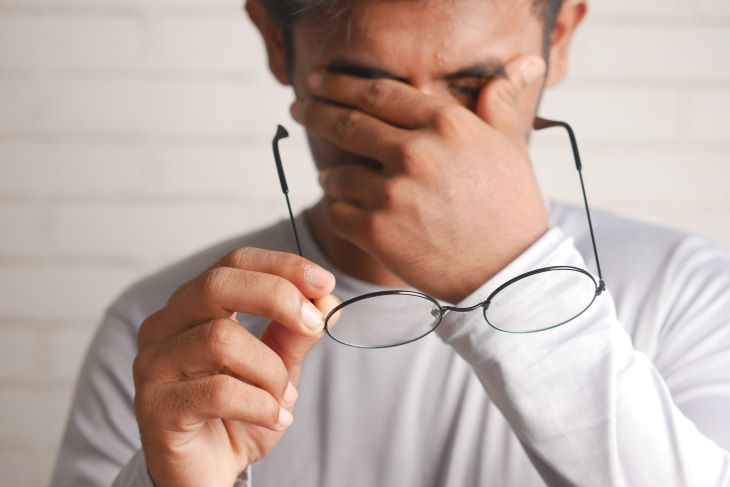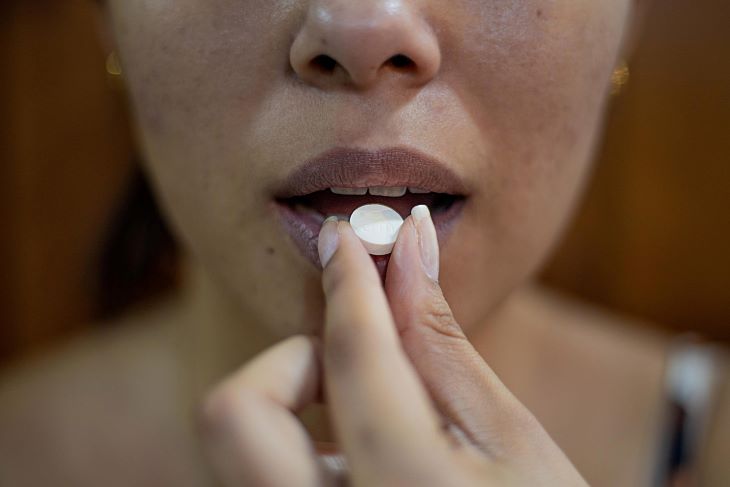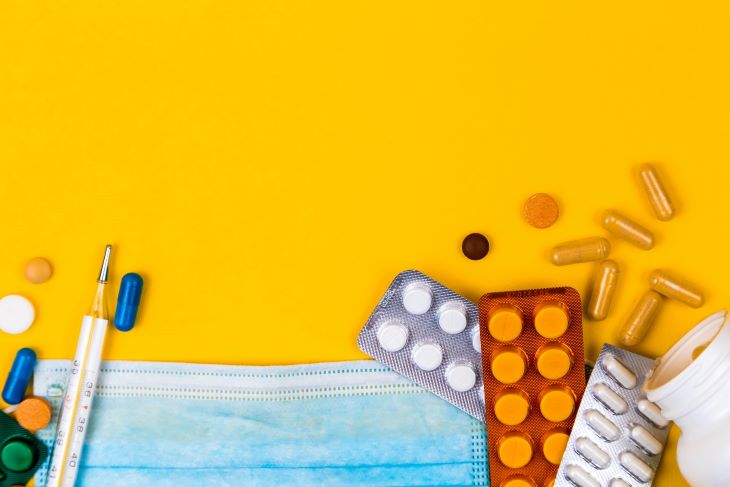Tramadol is an opioid, taken as a painkiller much like morphine and oxycodone.
Although it is used as a medication and has a lower potential for abuse than other opioids, those who consume tramadol on a regular basis are at risk of becoming dependent on it.
It works by blocking pain signals to the brain, providing individuals with temporary relief from moderate and severe pain.
However, this effect is coupled by a simultaneous boost in serotonin production, a neurotransmitter strongly associated with euphoric effects.
As tramadol is taken more regularly, an individual’s brain can become used to this influx of serotonin.
It can come to expect the pleasurable feeling and struggle to match the production when sober. As a result, the brain craves and demands more tramadol.
Sustained consumption can also affect how the body works. Over time, the body begins to develop a higher tolerance for tramadol, reducing the effectiveness of the same dosage.
Individuals then feel compelled to consume larger doses to numb their pain.
This trend continues to escalate until their body cannot cope without tramadol, experiencing withdrawal symptoms when sober.
These then motivate further tramadol usage, locking an individual into addictive cycles thanks to a physical dependence.

When the brain and body become hooked on consistent and excessive tramadol consumption, an individual is in need of tramadol detox.
This is a treatment which aims to alleviate this reliance and give individuals their independence back.
Tramadol detox sees individuals slowly and gradually reducing their tramadol consumption.
Because their body and brain are so used to the drug, suddenly quitting it will spark a violent response in the form of withdrawal symptoms, requiring a patient approach.
This process is often referred to as tapering off. It is also conducted under the watchful eye of doctors and addiction experts who oversee the body’s response to each phase of tramadol detox.
They ensure health is not threatened and aim to ease the process.
They initially do this by pacing the process in accordance with the body’s ability to cope, but they can also prescribe medications which dampen withdrawal and provide comfort.
Drugs like lorazepam and clonidine, for example, can help reduce anxiety and restlessness [1].
At Rehab 4 Addiction, we offer free advice from a team of non-judgemental professionals, many of whom are in recovery and understand how hard can be to change your relationship with addiction.
Simply reach out to our 24/7, confidential hotline on 0800 140 4690.

It is normal for individuals who are in need of tramadol detox to question its importance.
Is it not possible to wean yourself from your tramadol dependency, rather than undergoing a structured process and having to be monitored by doctors?
Unfortunately, this is not recommended.
While it is theoretically possible to become sober through willpower alone, there is a high amount of risk associated with it.
Without support, individuals can be seriously harmed as a result of unpleasant withdrawal symptoms.
In addition, the period of time immediately after detox is immensely important.
Within a tramadol detox programme, individuals will be equipped with the skills and techniques to maintain their sobriety. Alone, they are at high risk of relapse.

Withdrawal is a word a lot of us are familiar with, but what does it actually mean in the context of tramadol addiction?
Tramadol withdrawal refers to the response of the body and mind to sobriety after a prolonged phase of consistent consumption.
Chemical and hormonal balances, which have begun to rely on tramadol’s constant presence, begin to collapse and cause fluctuations.
The brain, which has begun to take the regular serotonin boosts provided by tramadol for granted, also experiences instabilities, resulting from a sudden lack in serotonin that it is ill-equipped for compensating for.
The importance of withdrawal lies in the variety of ways it can impact people.
Due to both the brain and body reacting so wildly, symptoms can be physical, cognitive, and emotional.
Without appropriate handling, individuals can come to serious harm.
At Rehab 4 Addiction, we offer free advice from a team of non-judgemental professionals, many of whom are in recovery and understand how hard can be to change your relationship with addiction.
Simply reach out to our 24/7, confidential hotline on 0800 140 4690.

Tramadol withdrawal is different from that of other opioids, and this results from how they differ in their approaches to numbing pain.
Most opioids like hydrocodone work by activating opioid receptors in the brain known as G protein-coupled receptors (GPCRs) [2].
GPCRs regulate the body’s reaction to different drugs and hormones, and they play a large role in the brain’s experience of pain. When activated, pain is essentially numbed.
Tramadol, however, carries out this function while also treating pain in its own way.
As well as targeting GPCRs, tramadol blocks the re-uptake of serotonin and norepinephrine [3], increasing the concentration of these neurotransmitters in the brain.
As a result of this dual approach to pain management, those addicted to tramadol can experience two kinds of withdrawal – traditional opioid withdrawal and atypical opioid withdrawal.
Both of these kinds come with their own set of symptoms.

So what are the symptoms of tramadol withdrawal? Firstly, individuals can expect to potentially experience some of the physical symptoms associated with traditional opioid withdrawal. These include:

Additionally, atypical opioid withdrawal can trigger some of the following tramadol withdrawal symptoms:
At Rehab 4 Addiction, we offer free advice from a team of non-judgemental professionals, many of whom are in recovery and understand how hard can be to change your relationship with addiction.
For more information about tramadol detox Simply reach out to our 24/7, confidential hotline on 0800 140 4690.

When an individual quits their tramadol consumption, they can expect to go through withdrawal for around 10 days.
Sometimes it can last as little as 4, and if they have access to medical support, it can be reduced almost completely.
Symptoms will begin to manifest within the first 24 hours of being sober.
Those with severe conditions, however, can expect to experience the first signs of withdrawal within just a few hours.
Typically, the severity of symptoms will continue to increase over the next few days, reaching their peak usually within 3 days.
From that point, symptoms will die down though remain present and noticeable for the remainder of the 7 days.
Some individuals can experience symptoms for longer. Known as Post-acute Withdrawal Syndrome (PAWS), symptoms can sometimes last for several weeks or months.

It is normal for there to be a level of variation between different people’s experiences of tramadol withdrawal.
These result from a number of severity factors which affect people differently and can produce diversity in symptom severity and duration.
At Rehab 4 Addiction, we offer free advice from a team of non-judgemental professionals, many of whom are in recovery and understand how hard can be to change your relationship with addiction.
Simply reach out to our 24/7, confidential hotline on 0800 140 4690.
Perhaps the most obvious reason for more severe withdrawal is the extent to which an individual has been addicted to tramadol.
Using the drug for years and years will lead the brain and body to develop intense and thorough dependencies on tramadol.
Breaking this reliance and thrusting the body into independence after years will naturally produce a greater reaction than if tramadol has only been used for a number of weeks.

Our body is made up of millions of genes that we have inherited from our parents.
They play a major role in determining our features, and they can strongly impact our experiences of addiction and withdrawal.
Some people can inherit genes which affect the symptoms they experience, how severe their withdrawal is, and how long they experience the negative effects of becoming sober.

The state of an individual’s wellbeing prior to withdrawal can strongly affect how they are affected by becoming sober.
Because opioids like tramadol are taken to soothe pain, the extent of an individual’s pain can influence how much they suffer.
Those with chronic pain, for example, can experience rebounding pain on a much more serious level than those with more manageable pain.
But it isn’t only pain-related conditions that have an impact. Those with poorer physical health can experience symptoms relating to sleep, illness, and motor skills with much greater severity.
The same can also be said for those with poorer mental health.
Symptoms like anxiety, paranoia, and panic attacks can exacerbate pre-existing psychological difficulties and affect an individual’s life much more seriously.
At Rehab 4 Addiction, we offer free advice from a team of non-judgemental professionals, many of whom are in recovery and understand how hard can be to change your relationship with addiction.
Simply reach out to our 24/7, confidential hotline on 0800 140 4690.

It’s difficult to judge whether a loved one is in need of tramadol detox.
Are they addicted, or are they in pain and take the drug on a regular but healthy basis?
In order to know for sure, there are signs that you can look out for. These include:

Withdrawal is a big risk that comes with going through tramadol detox.
Even though the process is paced to minimise the likelihood of symptoms arising, they can still be a great source of anxiety, discomfort, and even pain while individuals try to get sober.
As a result, medication plays a really important role in tramadol detox.
When individuals get withdrawal symptoms, benzodiazepines can be prescribed to calm them and provide relief.
The significance of this is invaluable. Not only does it protect health and wellbeing, reducing the risk of harm almost completely, but it hugely affects an individual’s motivation.
They will be much more committed to continue with treatment if they are comfortable.
At Rehab 4 Addiction, we offer free advice from a team of non-judgemental professionals, many of whom are in recovery and understand how hard can be to change your relationship with addiction.
Simply reach out to our 24/7, confidential hotline on 0800 140 4690.

Outpatient services are a common and frequently accessed source of support when it comes to addiction recovery.
In respect to tramadol detox, however, individuals should only use inpatient (or residential) programmes, and there are several reasons for this.
Primarily, inpatient programmes are the only service capable of providing tramadol detox.
Outpatient services can offer guidance and support, but without 24/7 supervision and on-site accommodation, they cannot observe and facilitate the gradual reduction of usage.
Inpatient’s ability to keep an eye on individuals also means that it is the only way to safely undergo the process.
A medical team are always on hand in the event that withdrawal gets out of hand, and the process can be closely monitored to reduce risk altogether.
But it isn’t only physical health that benefits.
With doctors always being available, as well as other recovering individuals also going through detox, individuals have access to support, guidance, information.
This support along with guiding words of encouragement help to maintain their mood and mindset.

Once physical sobriety has been achieved and an individual no longer feels the overpowering urge to consume tramadol, they have the opportunity to work through the underlying causes of their desire for the drug.
Detox grants them independence to work through whatever compels them to take the drug.
These triggers can be mental, physical, social, emotional, behavioural – regardless, the approach to working through addictive triggers is via therapy.
Therapy is a treatment method which can adjust itself to suit whatever strategy an individual requires to target their personal triggers.
It can prioritise thought processes, the handling of emotions, familial relationships, the navigation of work situations, etc.
Whatever the approach, therapy looks to build upon the progress of detox.
This gives individuals the techniques to sustain their sobriety into the future without the impulse to take tramadol manifesting into relapse.

Once therapy has equipped an individual with the knowledge and techniques to sustain their sobriety, they will return to their normal lives and have to put their newly established skills to the test.
To support them in this, tramadol rehab programmes often have a final stage: relapse prevention.
During this, therapists and addiction experts help individuals practice additional techniques that they can use to ensure they do not require tramadol detox again in future.
Such techniques might include:

Once an individual has completed detox and beaten their physical dependency, as well as undergone therapy and relapse prevention to prepare themselves for day-to-day life, their journey is not yet over.
In the long-term, individuals can still get support for their ongoing battle against tramadol addiction.
This primarily comes in the form of aftercare, and it can help both with detox and tramadol therapy.
Attending sessions in their local area, individuals can meet with medical professionals and addiction experts to get advice as to how to maintain their physical independence from tramadol and maintain a comfortable level of physical health and wellbeing.
To keep making progress on the psychological front, they can attend group therapy sessions to reinforce what they have learned about the dangers of tramadol addiction and how to combat addictive triggers.
At Rehab 4 Addiction, we offer free advice from a team of non-judgemental professionals, many of whom are in recovery and understand how hard can be to change your relationship with addiction.
Simply reach out to our 24/7, confidential hotline on 0800 140 4690.

Perhaps more frightening than realising you require tramadol detox is suspecting that a loved one might.
Even more disturbing can be such a friend or family member not realising that they are struggling. But what can you do in this kind of situation?
The first approach to consider might be to simply try and talk to them about their tramadol use.
Open a discussion about whether they have realised how often they are consuming it, and speak from an honest standpoint of love and concern for their wellbeing.
If this does not work, another option is to hold an intervention.
This technique sees a group of family and friends coming together to supportively communicate their concerns to the individual, using instances where their tramadol use has had negative effects.
Both of these approaches have the goal of encouraging a loved one to see the error of their behaviour and seek the appropriate support.

It can be really dangerous to try and go through detox at home without any support.
However, that is not the only way an individual can wean themselves from tramadol use without having to go into a treatment facility.
Home detox programmes are a viable way to beat physical dependency, and they involve the delivery of benzodiazepines to an individual’s home for them to take as they go through tramadol detox.
They also attend meetings with an expert to monitor their progress.
Although prices can vary, home detox programmes tend to cost around £1,500.
The advantage of home detox is that it limits the disturbance of an individual’s everyday life.
Without having to enter a detox programme, work and home life is able to continue as normal.
At Rehab 4 Addiction, we offer free advice from a team of non-judgemental professionals, many of whom are in recovery and understand how hard can be to change your relationship with addiction.
Simply reach out to our 24/7, confidential hotline on 0800 140 4690.

However, the extent to which these programmes can help is very limited.
Although regular check-ups are designed to ensure safe detox, those with severe tramadol addiction will experience far too serious withdrawal to be able to cope without 24/7 support.
Additionally, while undergoing detox at home might seem more comfortable, it means individuals have very little access to those who understand what they are going through.
Family members can offer love and support, but the advice and experiences of doctors and others going through the same experience will be missed, as will the resulting atmosphere of camaraderie and mutual encouragement.

Suspecting that you or someone you care about might need tramadol detox can be surprising, shaking up your world and causing a lot of distress or confusion.
But that doesn’t mean that tackling the problem need be done alone.
Rehab 4 Addiction has a team that are available and dedicated to help you through this tough journey.
Whether you need information, advice, or someone to point you in the right direction of suitable tramadol detox, we are here to help.
At Rehab 4 Addiction, we offer free advice from a team of non-judgemental professionals, many of whom are in recovery and understand how hard can be to change your relationship with addiction.
Simply reach out to our 24/7, confidential hotline on 0800 140 4690.

[1] https://www.ncbi.nlm.nih.gov/pmc/articles/PMC2882815/
[2] https://www.nih.gov/news-events/nih-research-matters/how-opioid-drugs-activate-receptors